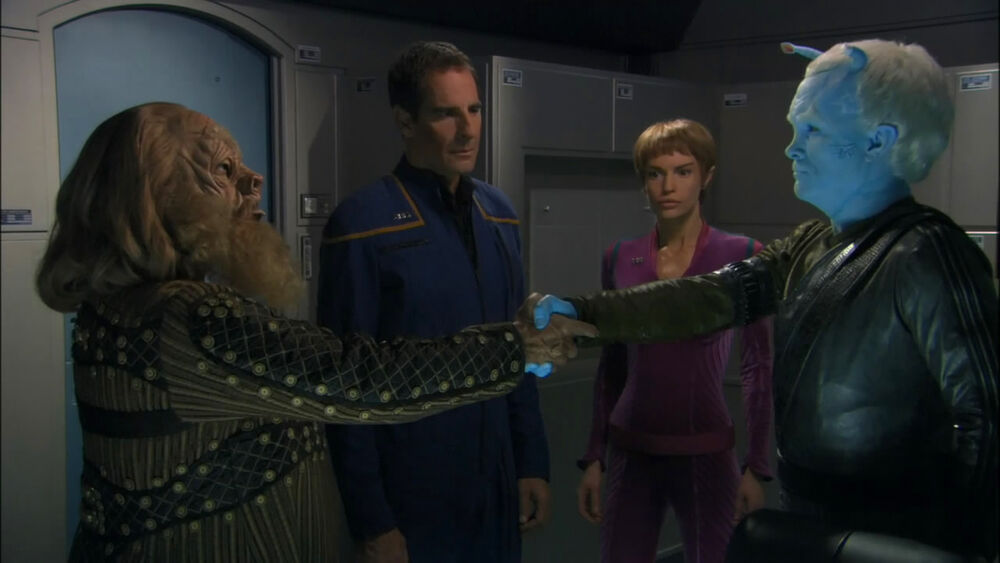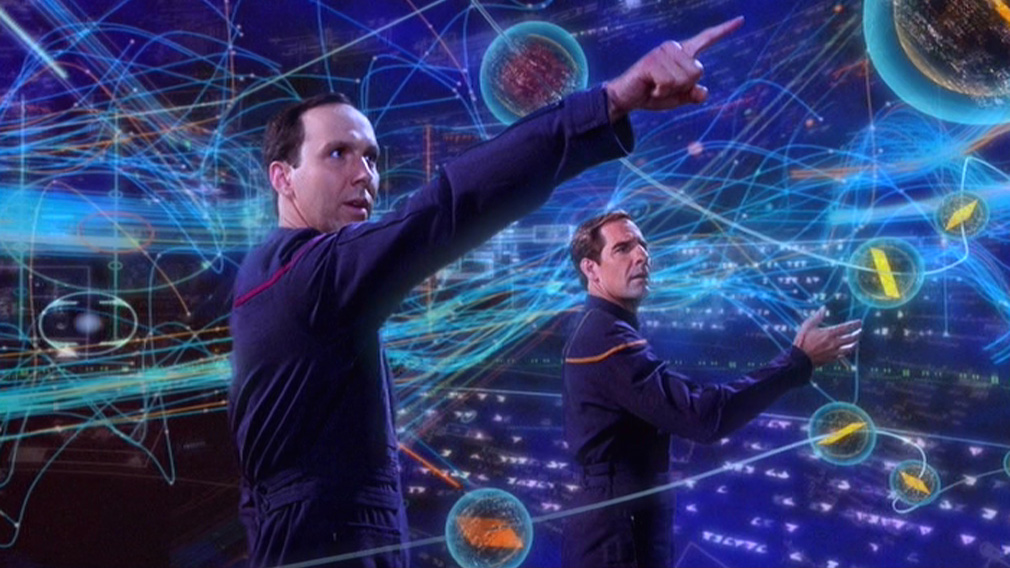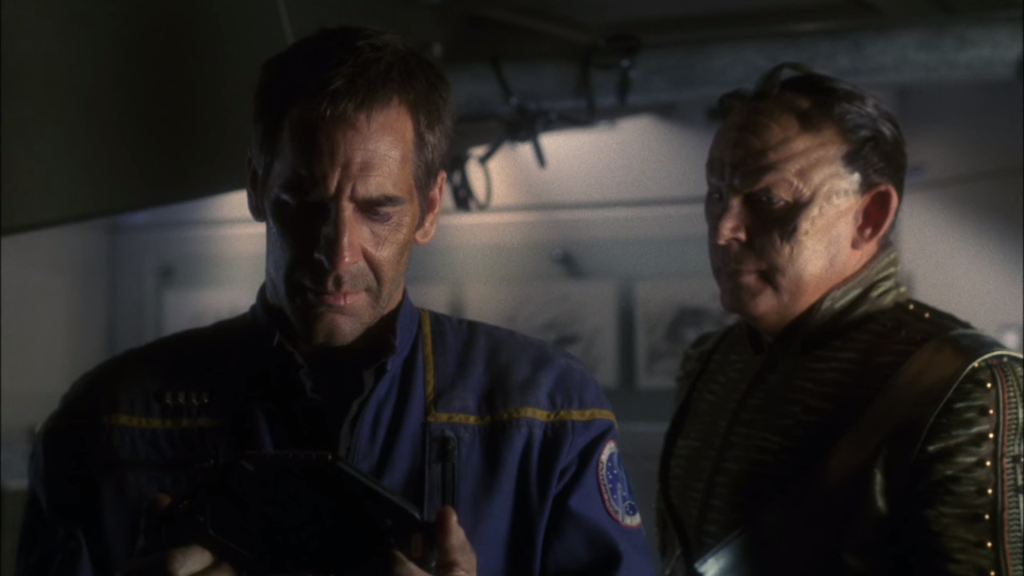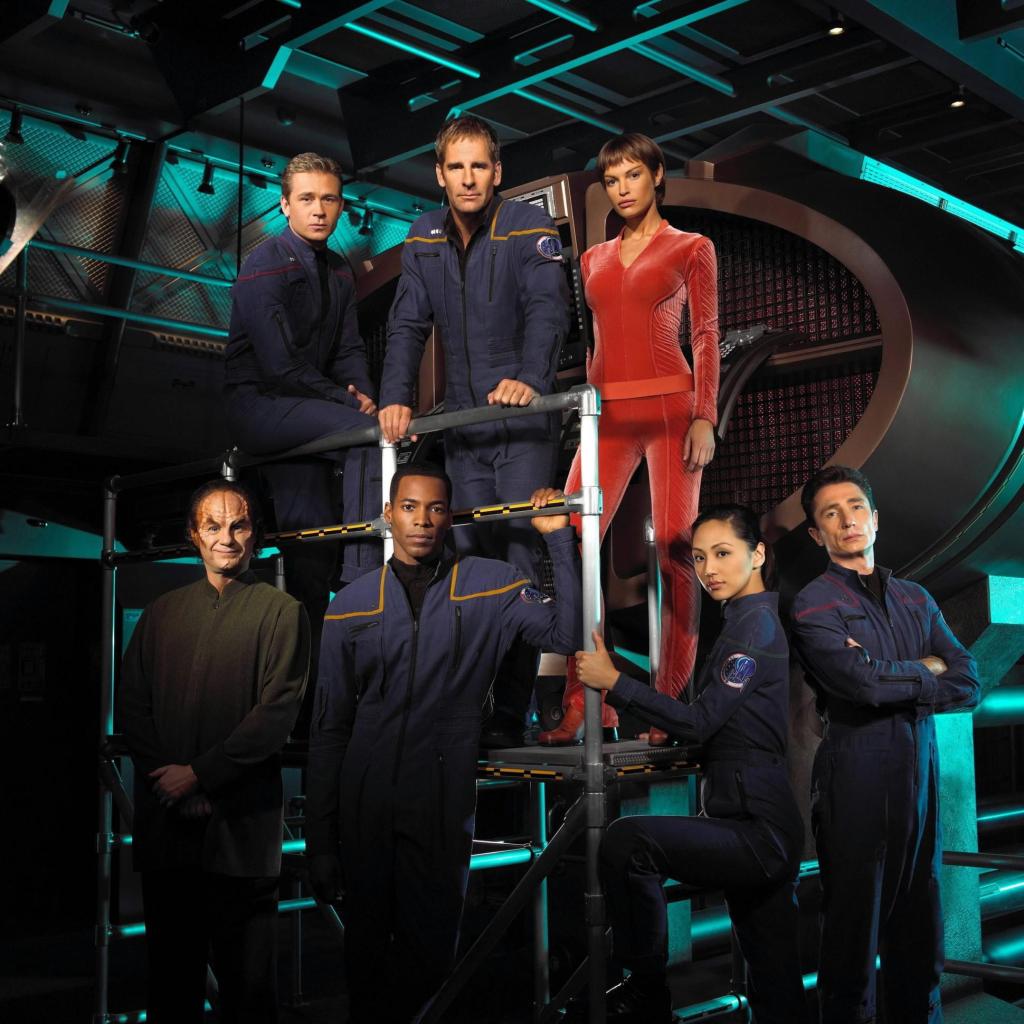I don’t think I’ve really made it clear on this blog before, but I am, in fact, a huge Trekkie. Been one ever since I can remember. In kindergarten, I spent a day painting my rendition of the duel between the Enterprise and the Reliant, and in third grade, I would zealously record reruns of various Trek installments as they aired on television, though unfortunately I only caught a few seasons before the DVR broke1. While these days I am more of a Warhammer 40,000 and Star Wars fan, I still adore Star Trek for the foundational role it played in my childhood. This nostalgia is probably common among nerds; what’s less common, I imagine, is that the show I remember most fondly is one many fans would like to forget: Star Trek: Enterprise.

Enterprise gets a bad rap. It is the Star Trek equivalent to the Star Wars prequels, also produced in the early 2000s and poorly received at the time, though both have been viewed more kindly in light of new (and terrible) installments in their respective franchises. Critics of Enterprise complained on the early message boards about bad writing, cartoonish attempts to be hot and hip, and rampant continuity errors, as well as the first and second seasons’ aping of the TNG/Voyager format; more generally, the franchise was suffering from fatigue, having been on the air continuously since 1987. The network saw these complaints and the attendant poor ratings, and cancelled the show after a mere four seasons. Tragically, Enterprise was at its very best just before the end.

The first season began with the pilot, “Broken Bow,” in September 2001, months after Voyager‘s “Endgame” brought Janeway and her long-suffering crew back home; the last season ended with “Terra Prime”2, airing in May 2005. Since December 2018, my two best friends and I have been watching the whole series3, episode by episode and start to finish—this was initially a joke, along the lines of “Hey guys, let’s suffer through this hilariously bad show and make fun of it,” but in the process of our long marathon I have come to adore what is one of Star Trek‘s quirkiest installments.
Enterprise takes place in the 2150s, long before Kirk’s day. The Federation does not exist yet—rather, humanity is merely a fledgling player on the galactic scene, still under the tutelage of the far more advanced Vulcans. To date only a few slow cargo freighters and colony ships have made the sometimes years-long journey to nearby star systems; that all changes, however, with the launch of the Enterprise NX-01, the first Earth vessel capable of Warp 5 (we’re told it’s very fast), and the doors of the cosmos are suddenly flung open…


The Enterprise crew comprises seven main characters (pictured near the top of the post). There is, of course, the brave captain, Jonathan Archer, the son of the man who spearheaded the development of the Warp 5 engine. He is played very charmingly by Scott Bakula; few, if any, Star Trek captains have been as approachable as Archer, and on top of that he is very much a driven, curious, well-intentioned (if often misguided) explorer. One could compose a long list of stupid decisions he makes throughout the series, but to a degree that’s to be expected for the inexperienced commander of Starfleet’s very first Warp 5 vessel. Now, Archer does start off as fairly prejudiced towards Vulcans4, mainly because he blames them for delaying the Warp 5 project and holding humanity back in general, but fortunately he drops that after a season or two.
Next up is Enterprise‘s second-in-command and science officer, T’Pol (Jolene Blalock). Her job is essentially to supervise Archer’s mission of exploration, offering advice and also reporting back to the Vulcan High Command. She is the ship’s only Vulcan and one of two aliens aboard, so at first she fits in very poorly—it doesn’t help that she’s aloof and humorless, while Archer is initially kind of a jerk to her—but it doesn’t take long before she becomes a valued member of the crew, going so far as to resign her High Command commission and serve exclusively on Enterprise as an exceedingly capable right-hand woman.
The third member of the power trio is the chief engineer, Commander Charles “Trip” Tucker III, played by Connor Trinneer. Connor Trinneer is an absolute joy to watch; like Bakula, he is very warm, wholesome, and all-round likeable, and he’s got an entertaining Southern accent to boot. Over the course of the show he shows a tendency to do whatever he thinks is the right thing at the time, regardless of whether it turns out to be a good idea. He’s noble, but at the same time he’s ill-informed and impulsive, making him an excellent symbol for humanity in this early era of space travel.

Rounding out the cast are four more characters. First we have Malcolm Reed, the tactical officer, who is an exceedingly by-the-book fellow with a penchant for blowing things up. He’s pleasant to watch on the screen, if not extremely memorable. The ship’s doctor, on the other hand—now there’s a character. Doctor Phlox, played by John Billingsley, may not be the most competent of Star Trek‘s doctors, or the most ethical5, but he is at once affable and unbelievably quirky, certainly up there with Dr. McCoy and Robert Picardo’s EMH in terms of sheer, delightful entertainment value.
There is also the communications officer, Hoshi Sato, played by Linda Park; she is a linguistic genius, vital for Enterprise‘s alien encounters in an age before the universal translator, but eventually the producers got tired of having every first contact feature a long period of mutual incomprehensibility, and so she got sidelined into doing odd jobs throughout the rest of the series (when she was lucky enough to get screentime at all). Also sidelined is Travis Mayweather, the pilot, played by Anthony Montgomery. It’s a shame because he is the only member of the crew to have been born on a space freighter, and while that idea’s potential was touched upon a couple times, it was never really utilized. I reckon that big-name recurring characters like Shran and Degra might have gotten more lines than poor Travis…

So, we have our intrepid crew. But how does the show play out? Well, Enterprise starts off as fairly conventional Trek, with the first two seasons comprising standalone episodes about the ship’s adventures through space and encounters with alien lifeforms. Some such lifeforms are franchise heavyweights like the Romulans, Klingons, and Borg (!)6, while many others, like the shapeshifting Suliban and the Xindi, are introduced even though the later shows make zero mention of them. Guess they up and vanished between installments.
There are a few good 22nd-century twists that set this series apart from the TMG/Voyager/DS9 era: most prominently, the Federation is nowhere to be seen, and while Earth is a protectorate under the Vulcans, the Federation’s other founding races, like the Andorians and the Tellarites, are constantly at each other’s throats. The transporter device is in its infancy, used only in emergencies; replicators and holodecks do not appear, as they do so frequently in TNG and Voyager, though run-ins with advanced alien species tease the technology. Connections to Star Trek‘s future are made even more pronounced by the Temporal Cold War arc, which (rather incoherently) shows various factions from the later centuries interfering with Archer’s grand voyage.

Despite some interesting ideas, and strong installments (“Cogenitor,” “Carbon Creek,” “Minefield,” “Regeneration,” and “Shuttlepod One,” to name a few I really enjoyed), the first two seasons are largely wheel-spinning, a retread of material TNG and Voyager did somewhat better. Due to poor ratings the network decided to try something decidedly different for Season Three. Thus, we got the fully serialized Xindi arc: a hitherto unknown species (federation of related species, really) appears out of nowhere to attack Earth with a prototype Death Star-esque superweapon, and Enterprise must go on an expedition into a supremely dangerous region of space to prevent them from finishing the job. What follows is a riveting adventure and war storyline, decidedly darker in tone than the series up to this point. Many fans, myself included, mark Season Three as the time Enterprise really hit its stride—it tells serious, thoughtful, suspenseful stories and links them together into a grand season-long arc.

So yeah, Season Three is fantastic. What about Season Four? Well, for the last season they brought Manny Coto onboard as showrunner, and he stepped the show up yet another notch in quality, producing a long series of “mini-arcs”—each two to three episodes long—that set the stage for the Original Series while also bringing new, exciting ideas to the table. We see renegade superhumans, a schism-turned-civil war in Vulcan society, the beginnings of the Federation, and some wacky hijinks with Klingons, all exceedingly well executed. There’s only one bad episode, the one about the Orion slave girls; there would have been another bad one, hypothetically, if they had produced a finale that essentially slapped the show in the face while killing off a beloved character, but that’s just crazy talk. The so-called “terrible Enterprise finale” is a legend told around campfires to frighten children, and it has no basis in reality.
Anyway, right before the very last episode, the good but not extremely memorable “Terra Prime,” Enterprise ventures into the rarely featured Mirror Universe with a wild, bombastic two-parter, indisputably a highlight of the whole show. It asks the question: what if everybody were evil? Thus we see the vicious Terran Empire ruling the stars, a human-supremacist totalitarian regime complete with snappy uniforms and an even snappier logo, where everybody is willing to lie, torture, and backstab their way to the top. The actors, to their credit, go all-out with the premise and usher in an hour and a half of spectacular, dazzling insanity. It actually has zero effect on the rest of Enterprise, but that doesn’t matter because it’s jolly good fun.

I just finished marathon-watching Enterprise with my good friends, wrapping up a project that has been underway since 2018, and forcing a sad goodbye to some characters I have really grown to love. Everybody loves to hate on Enterprise, but it is just as worthy as Voyager; both series have amazing casts as well as their own moments of brilliance.
That isn’t to say that everything is fine and dandy. There are some truly terrible, no good, very bad episodes in the mix, a few of them even contending for the spot of worst in the franchise (looking at you, “A Night in Sickbay”). And especially early on, the showrunners made some awful decisions trying to make the show sexy, squeezing in the much-derided “decontamination” scenes—really just an excuse for cast members to strip to their underwear under blue lighting and rub each other with gel. There will not be a screenshot for this one.

Any review of Star Trek: Enterprise would be incomplete without touching upon the widely reviled country-style theme song, “Faith of the Heart,” a considerable departure from the franchise’s earlier, more serious credits music. I too used to bash the song; after 98 episodes, though, I can unironically say that I love it to bits. My friend probably has a video somewhere of me (very badly) singing along to the lyrics, late at night in a dormitory lounge. Sophomore year was a hoot!
Now, Star Trek: Enterprise was the very last televised Star Trek to air, up until the release of Discovery in 2017 and the revitalization of the franchise. How does it stack up against the new shows? Well, you probably remember how everyone bashed on the Star Wars prequels right up until TLJ proved the sequels were hot garbage, and it is very much the same here. Discovery‘s crimes against continuity make anything Enterprise did look downright trivial. Add to that a mounting succession of absurd shock-value plot twists, plus the far more serious problem of a vastly darker, gratuitously bleak tone undercutting everything Star Trek ever stood for, and you have a total mess with no respect for its heritage. Don’t even get me started on Picard, which takes character assassination to a whole new level7. Lower Decks looks like trash also. Unless the second and third seasons of Discovery are dramatically different from the awful first one that I saw, which may well be the case8, I maintain that Enterprise was the last real Star Trek show to air, and all following ones are impostors.

So. I’ve just spent my longest blog post yet explaining why Star Trek: Enterprise is a flawed classic, undeserving of its poor reputation. I obviously recommend watching it. Even Enterprise at its worst has a goofy charm and likeable characters, such that the bad episodes are good for lampooning with friends, and of course the best ones fit right in with Star Trek‘s long, proud lineage, adding new depth and a new era to one of the greatest sci-fi properties out there.
Rating: 8/10 for objective quality, 10/10 for childhood nostalgia!
- Possibly because my cat kept sitting on it. Come to think of it, I haven’t so much as seen a DVR in almost a decade. It is ancient technology, a relic of a bygone era, like horse cavalry and typewriters.
- No, there was not, in fact, an episode after “Terra Prime,” and certainly not one named “These are the Voyages…” in which the crew only appeared as simulations in Commander Riker’s TNG-era holodeck program. Anyone who claims to have seen such an episode is clearly delusional.
- I think we missed “Kir’Shara” in Season 4, though. My friends insisted that we’d already seen it, and wanted to go on to the next episode, but I don’t remember actually finishing the Vulcan arc. I’ll have to badger them about it sometime.
- On the other hand, many of the Vulcans we see in the first few seasons are kind of jerks, certainly stuck-up, humorless, and condescending, as well as brazenly hypocritical. They mellow out in Season 4.
- In one episode he grows a sentient clone of Trip, with the sole intention of lethally harvesting the clone’s organs and giving them to the real Trip. It’s slightly more reasonable in context… but only slightly.
- Yes, it’s a canon violation, but it’s damn cool and almost semi-justified.
- Literally, in many cases. I will never forgive them for what they did to Icheb…
- No, I’m not going to see for myself by getting CBS All Access, and you can’t make me. Locking high-value IP like Star Wars and Star Trek behind expensive, company-specific platforms is a bad practice and should not be encouraged.
